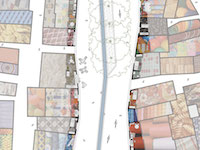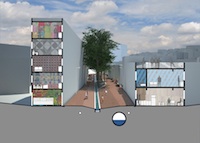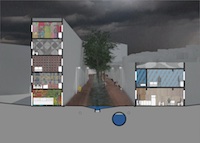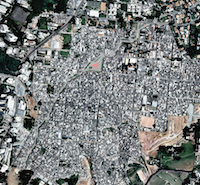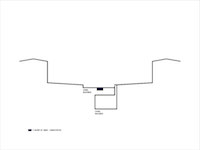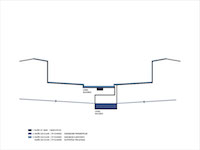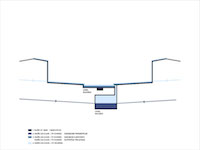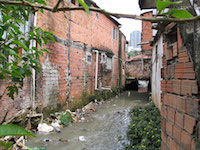BRASILE. Dall'architettura sostenibile, una nuova dignità urbana a cura di Carlo Pozzi con Claudia Di Girolamo
torna suPROGETTO URBANO “CÓRREGO DO ANTONICO” Maria João Figueiredo (MMBB Arquitetos)
The urban project “Córrego do Antonico” is contained in the Urbanization Program of Favelas promoted by the Municipal Secretary for Housing of São Paulo (SEHAB).
Paraisópolis is the second largest favela of the city, with about 60,000 inhabitants who live in approximately 1 square kilometre. It sprang up as the development of the informal occupation of an irregular piece of land, set in rugged land with a rectilinear and orthogonal network. The Antonico stream cuts through this road network diagonally and is currently covered by precarious buildings that were built along its course during the 20th century.
Though the favela appears to have a consolidated urban fabric, in the low areas around the stream, among the other volumes, we find an area with buildings which are decidedly risky. Near the stream the road system is more problematic; the buildings are often older and, above all less stable. Currently the waters of the Antonico receive much of the sewage of the favela and, during each summer, are responsible for the collapse of several buildings. The dynamism of this area is proved by the new homes and commercial locations that are constantly appearing to replace those which have collapsed.
So recovering this element and dredging it are absolute imperatives in the urbanization program of the Paraisópolis favela, which contains a variety of infrastructure works, social structures and new residences. The urban project “Córrego do Antonico”, beyond being only a technical solution for these problems, aims at offering proposals which will bring a marked improvement to the living condition of the entire favela.
Currently, in the state of São Paulo, the guidelines for the development of new drainage projects forbid the burial of rivers or streams. This principle, in the case of a tropical river regime, requires the availability of a vast flattish area for flood plains where the river can expand during strong rains. The approach adopted by São Paulo starts with an in depth study of the amount of runoff from the various feeder streams and plan for the maximum values recorded over the last 100 years. In the case of a situation of intense urbanization, the maximum runoff from rain is higher than it is in normal hydrological conditions. It is obvious that the depth of ground water recedes below the city and that the spaces set aside for flood basins are underused most of the time.
The drainage project for the Córrego do Antonico attempts a reconciliation of the favela with its waters, not reading them as a problem, but rather seeking to exploit them in the everyday life of the population. The proposal is to distinguish the various flows. Only the base flow (today covered) will be maintained on the surface, in an open channel, increased by the higher runoff from precipitation in a sub-basin uphill from the stream and by the waters from atmospheric precipitation on the surface of the project near the channel, maintaining a constant flow, controlled and compatible with the crowded urban setting. Runoff from heavy rains will be guided by micro-drainage from the surrounding area and excessive amounts will have been removed by a skimming system planned for the upper channel which will send them into a subterranean tunnel, called lower channel, which will not enter into conflict with the urban fabric of the favela. Thus the big floods that, violently collect a large quantity of varied pollution, will be channeled into this closed subterranean channel, and separated from the public spaces where people walk.
There is every hope that this restructuring of the sewage network will be effective. The surface waters that will be conducted into the upper open channel will be sufficiently clean to allow the population to come into contact with the “new” stream. The hydraulic project plans for a flow between 0.09 and 0.986 m³/sec and the speed will be between 0.64 and 0.73 m/sec for the upper channel. However the maximum capacity of this channel will be 2.527 m³/sec with a speed of 1.05 m/sec. The capacity of the lower channel, which has been planned keeping the figures of the last 100 years in mind, will be between 3.33 and 16.525 m³/sec and the maximum speed of the water will be 3.47 m/sec.
The drainage project and the reconfiguration of the free areas as a result of the removals constitute the initial aim of this work. However the main question that must be faced is the future maintenance of the open areas, so as to avoid their being used for new irregular squatting. The project starts from the premise that it is possible to reconceive the model for the drainage system, in such a way that the answer will satisfy both the technical aspects of the hydraulic system and also favour the development of urbanity in the spaces it crosses.
The re-urbanization works of the Antonico require the removal of irregular buildings near the stream in areas that the stream makes risky. Along and parallel to the channel there will be an open space at least 10 metres wide (up to 15 m at some points) obtained by removing 531 units. The forecast is that in a successive phase a further 174 buildings will be removed to create new open spaces and facilities.
The new public path which will cross the favela will be the main axis of internal mobility in the area. Placed in the areas will the gentlest slopes in Paraisópolis, it is the most appropriate route for a bycicyle-pedestrian path. At one end of the project there will be the Américo Mourano Station of the future 17-gold line of the metro. Somewhat further away from the favela is the São Paulo-Morumbi Station of the 4-yellow line which can be accessed by way of a prolongation of the bike path that follows the course of the Córrego do Antonico almost to its mouth. This should make circulation the main promoter of the dynamics that actively protect the open spaces for public use.
Complementary to its use for circulation, a strip which is on average 1.7 metres wide will remain available to the inhabitants of houses near the stream; this area has been named Expansion Zone. The buildings, that earlier had open areas toward the stream, are to be allowed to enlarge, restructure and/or transform them into commercial services. A new urban front will arise. It will give birth to and allow the growth of local economies along its route.
The channel project, if not viewed as a technical production, will create a linear centrality composed of the juxtaposition of public and private spaces open to the population giving to them innumerable possible significances. Aside from the insertion of water into the landscape and its insertion into the everyday life of the favela, the project must create in the area the feeling that some type of public domain exists.
The presence of water and the existence of new open spaces for leisure time together with the stream will evoke the beach culture. We recognise that in urban beaches we encounter one of the most powerful spatial structures of Brazilian cities: the promenade, a space for meditation between the areas set aside for rest and the areas used for the city’s everyday life, in this space spontaneous forms of use generate an active and desirable co-existence.
The urban project “Córrego do Antonico” may transform itself into the main structure articulating the public spaces of Paraisópolis, and consequently, become one of the main instruments to promote urbanity in the neighbourhood. The association of free space with public spaces for public use is important to stimulate in the population a feeling of collectiveness and developing and building within them of an image of how they too can utilise the space.
